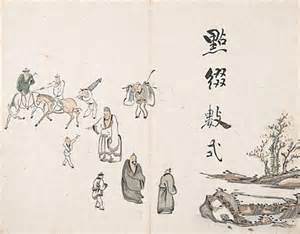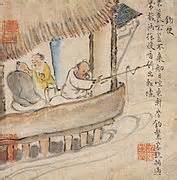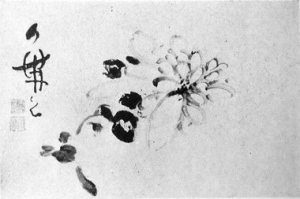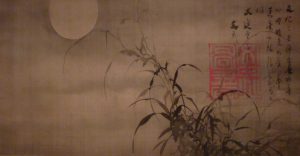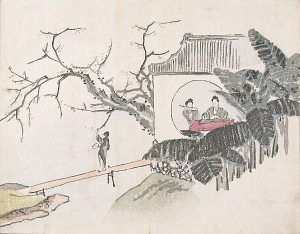Art of Japan and Bunjin Ideas in the Edo Period: Richness of China, Japan and Korea
Lee Jay Walker
Modern Tokyo Times
The Bunjinga school of thought ran deep within the literati of Japan during the Edo period. Bunjin (literati) artists trace their artistic roots to the literati of China during the Song Dynasty (960-1267). However, the differences between the Japanese literati and Chinese literati, is notable because of the opposite side of the coin applying. Also, the isolationist policies of Japan in the Edo period meant that bunjin artists didn’t have the complete picture of the cultural reality of the Song Dynasty.
Bunjinga is also called Nanga and on the British Museum website it states that: “The Japanese Bunjinga school of literati ‘scholar-amateur’ artists flourished in the eighteenth and nineteenth centuries. It is also known as Nanga (‘Southern painting’). The school was based on the literati movement that developed in China over a long period of time as a reaction against the formal academic painting of the Northern Song dynasty (960-1126). Rather than technical proficiency, literati artists cultivated a lack of affectation in an attempt to tune in to the rhythms of nature. In Japan, this was only partially understood: many Japanese bunjin were simply trying to escape the restrictions of the academic Kanō and Tosa schools while imitating Chinese culture. At first, the only models available were woodblock-printed manuals such as the Kaishien gaden (‘Mustard Seed Garden’) and a few imported Chinese paintings. Some Chinese monks of the ōbaku Zen sect taught painting in Nagasaki. Unlike their Chinese counterparts, the Japanese bunjin were not necessarily carefree artists and scholars from wealthy, bureaucratic backgrounds, and many had to sell their work to make a living.”
The political reality of the Edo period meant that Japanese artists were forbidden to travel to China. This policy was called sakoku (locked country) and clearly this prevented the real study of the Song Dynasty. Therefore, the free movement of people leaving or entering Japan was enforced strictly and only limited “windows” were open.
Given this, the real terminology should be kaikin (maritime prohibitions) but from the point of view of bunjingaartists, then clearly sakoku created major restrictions in their pursuit of knowledge and reality. Japan wasn’t fully isolated because cultural meeting points happened with the people of Ryuku (Okinawa) and the Ainu. Also, Nagasaki, and a few other places, enabled outside cultural interactions despite the severe limitations on “real interaction” based on the freedom of movement.
Bunjinga artists therefore resided in a world where restrictions were put in place and clearly even in the modern world certain nations are still hostile to outside influences which threaten the status quo. For example, in modern day Saudi Arabia all converts from Islam face death, just like all converts to Christianity faced death during the Edo period. Meanwhile, in North Korea this nation wants to maintain severe restrictions on the outside world based on political motives. In both Saudi Arabia and North Korea many windows are open in the field of trade. However, despite the huge differences of these two nations, you do see aspects of sakokudespite major cultural, political, religious, and other differences in these societies.
Therefore, bunjinga artists in this period of history had severe restrictions to overcome. However, unlike ukiyo-e artists who focused on many aspects of Japanese culture, mythology, history, the spirit world, and so forth; for bunjinga artists their problems were different because of their admiration of Chinese culture. This meant that ukiyo-e artists could connect with the world they knew but for bunjinga artists much of their literati world was clouded by the restrictions of obtaining real knowledge of the world they wanted to portray.
Famous artists who followed the bunjinga school of thought applies to Gion Nankai, Sakaki Hyakusen, Yanagisawa Kien, Okada Beisanjin, Kameda Bosai, Hanabusa Itcho, Ike no Taiga, Watanabe Kazan, Yosa Buson, Uragami Gyokudo, Tani Buncho, Takahashi Sohei, Okada Hanko, Ki Baitei , Matsumura Goshun, Yokoi Kinkoku (1761-1832), Yamamoto Baiitsu, Nukina Kaioku, Takahashi Sohei, Nakabayashi Chikuto, and many others.
In an earlier article by Modern Tokyo Times it was stated that: “This school of thought flourished in the late Edo period and highlights the power of traditional Chinese culture in Japan despite the ongoing isolation of this nation. The bunjinga, the literati according to their mode of thinking, all had one binding feature and this applies to their deep admiration of traditional Chinese culture. This enabled their individuality to be linked together within the ideas and art work of bunjinga concepts.”
The Philadelphia Museum of Art comments: “The mid-eighteenth century in Japan was a time of political and social stability and economic prosperity. The Tokugawa family of military rulers (shogun) was firmly ensconced in the new eastern capital of Edo as the de facto political power, while the emperor reigned as spiritual and cultural sovereign in the ancient imperial capital of Kyoto in western Japan. Regional schools were established to spread the Chinese studies that the central government espoused along with the Confucian-based political system. The study of fields such as Chinese literature, music, and medicine became specializations among the educated elite of the newly rich merchant class as well.”
Therefore, while the Edo period is famous for being isolationist it is abundantly clear that the Tokugawa ruling elites spread the power of Chinese studies. This makes sense given the fact that the political system was Confucian based.
Influence of Korea
The role of Korea in this art movement is often neglected despite cultural interaction and influence which went in both directions. On the Princeton University Press website it is stated (based on the book by Burglind Jungmann): “It is well known that Japanese literati painting of the eighteenth century was inspired by Chinese styles that found their way to Japan through trade relations. However, because Japanese and American art historians have focused on Japanese-Chinese ties, the fact that Japan also maintained important diplomatic–and aesthetic–relations with Korea during the same period has long been neglected. This richly illustrated, cogently argued book examines the role of Korean embassies in shaping the new Japanese literati style, known as Nanga in Japan.”
“Burglind Jungmann describes the eighteenth-century Korean-Japanese diplomatic exchange and the circumstances under which Korean and Japanese painters met. Since diplomatic relations were conducted on both sides by scholars with a classical Chinese education, Korean envoys and their Japanese hosts shared a deep interest in Chinese philosophy, literature, calligraphy, and painting. Texts, such as Ike Taiga’s letter to Kim Yusöng and Gion Nankai’s poem for Yi Hyön, and accounts by Korean and Japanese diplomats, give a vivid picture of the interaction between Korean and Japanese painters and envoys. Further, the paintings done by Korean painters during their sojourns in Japan attest to the transmission of a distinctly Korean literati style, called Namjonghwa. By comparing Korean, Japanese, and Chinese paintings, the author shows how the Korean interpretation of Chinese styles influenced Japanese literati painters and helped inspire the creation of their new style.”
The book by Burglind Jungmann called Painters as Envoys: Korean Inspiration in Eighteenth-Century Japanese Nanga is very intriguing because the Korean angle is neglected too much. However, cultural interaction within the richness of Chinese, Korean, and Japanese culture, went in all directions. Therefore, irrespective of the alterations which developed because of different cultural concepts within each different society – and within regions of all societies which had different energies and thought patterns – the Korean dimension is a reality and needs to be studied and highlighted more.
Timon Screech (School of Oriental and African Studies, University of London) comments that: “This is an important book that will be useful to scholars and students alike. In elegant prose and with excellent scholarship, Burglind Jungmann proposes that Korean amateur painting had a large impact in Japan. This point has never been so closely argued before, in any language. The author has been diligent in finding little-known works in many collections around the world to support her claims. This is the first book on the subject, but it is much more than an introductory work.”
The bunjinga movement is interesting within the context of sakoku (locked country) because it opens up many intriguing questions. Also, the Korean dimension further hints at deep cultural interactions despite policies by the Tokugawa ruling elites.
Therefore, the bunjinga art movement is an area of great richness when it comes to art, thought patterns, cultural interaction, and understanding aspects of Japanese culture during the Edo period. Famous bunjing aartists have also left a rich legacy because of the art they left behind. This article is meant to intrigue people to delve into the many amazing artists who belonged to the bunjinga school of thought and then to focus on the shared civilization of Northeast Asia, despite the unique richness of all societies involved.
http://www.philamuseum.org/exhibitions/108.html?page=3
http://press.princeton.edu/titles/7743.html
Modern Tokyo News is part of the Modern Tokyo Times group
http://moderntokyotimes.com Modern Tokyo Times – International News and Japan News
http://sawandjay.com Modern Tokyo Times – Fashion
https://moderntokyonews.com Modern Tokyo News – Tokyo News and International News
http://global-security-news.com Global Security News – Geopolitics and Terrorism
PLEASE JOIN ON TWITTER
https://twitter.com/MTT_News Modern Tokyo Times
PLEASE JOIN ON FACEBOOK
https://www.facebook.com/moderntokyotimes
Some articles about Japanese art and culture are republished based on the need to inform our international readership about the unique reality of Japan.
